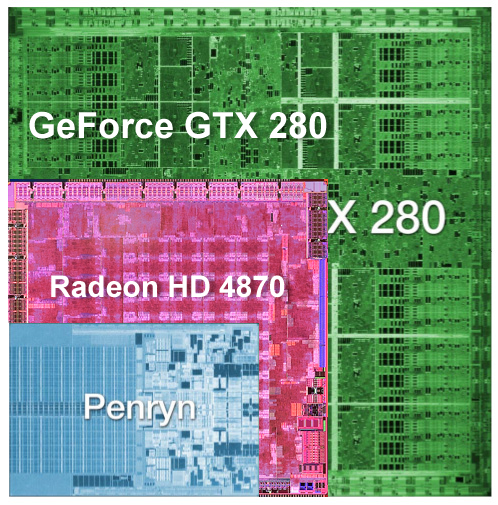The Radeon HD 4850 & 4870: AMD Wins at $199 and $299
by Anand Lal Shimpi & Derek Wilson on June 25, 2008 12:00 AM EST- Posted in
- GPUs
AMD's "Small-Die" Strategy
We outlined AMD's "new" GPU strategy in our Radeon HD 4850 preview article, but in short AMD has committed to designing GPUs for the mainstream $199 - $299 segment and simply using CrossFire (multi-GPU) to address higher end markets. NVIDIA on the other hand will continue to make very large monolithic GPUs in order to continue to push the industry forward. Both approaches are appreciated and necessary, they simply target different markets.
In our GT200 review we highlighted the fact that NVIDIA had built an extremely large, highly parallel, microprocessor. With 1.4 billion transistors and a die size of around 576 mm^2, NVIDIA's GT200 is nothing short of huge.
The table on the previous page shows that AMD's RV770, despite being aimed at mainstream gamer price points ($199 - $299), is also very large. At 956M transistors, the RV770 has 44% more transistors than RV670 and 68% the transistor count of NVIDIA's GT200. We threw the RV770 into NVIDIA's die size comparison just for kicks:

Based on what we know of NVIDIA's die size, this should be to scale
Even AMD's die, although designed to be svelte and affordable, is big - especially for being fabbed at TSMC. NVIDIA still holds the crown for largest die fabbed at TSMC, but AMD shows us that even a more mainstream approach still requires tons of transistors. As we mentioned in our 4850 preview:
"A pair of RV770s, AMD's new GPU, end up consuming more power than a single GT200 - despite being built on a smaller 55nm process.
A pair of these RV770s only costs $400 compared to $650 for a single GT200, but I suspect that part of that is due to differences in manufacturing process. If NVIDIA hadn't been so risk averse with the GT200 and built it on 55nm (not that I'm advocating it, simply posing a hypothetical), the cost differences would be smaller - if not in favor of NVIDIA since GT200 is built on a single card.
When the smoke clears, AMD's strategy is to simply build a GPU for the masses and attempt to scale it up and down. While NVIDIA is still building its GPUs the same way it has for decades, starting very large and scaling down.
AMD isn't taking a radically different approach to building and designing GPUs than NVIDIA, it's simply building one market segment lower."
We've got a lot of discussion on efficiency between AMD and NVIDIA coming up in this article, although AMD's die is noticeably smaller than NVIDIA's - as you've already seen with the Radeon HD 4850 - there are many areas where RV770 can go toe-to-toe with NVIDIA's mammoth GT200.










215 Comments
View All Comments
wilkinb - Wednesday, June 25, 2008 - link
Then include SLI for the 280... let the consumer care about what the value is or isn't, we all value different things. Provide the costs and the performance (SLI) please.Its make this very incomplete to not have included SLI for the 280/260, I for one will more then likely get 2 x GTX280's not all of us worry about a few $$, but if the CF 4870's are that good, then I want to know as I don’t care about the brand and will go with the best performance.
Can you please include them soon so we can make our own judgements on what's good or not?
Anand Lal Shimpi - Wednesday, June 25, 2008 - link
I've added the GTX 280 SLI numbers to all of the bar charts in the Multi-GPU section, enjoy :)Note, I didn't add them to the line graphs simply because we didn't have data for 280 SLI at lower resolutions. It only really makes sense at 2560 x 1600 anyways so this shouldn't be an issue.
Take care,
Anand
wilkinb - Wednesday, June 25, 2008 - link
thank you :)I really appreciate the response
Now I just need work out what to order.
paydirt - Thursday, June 26, 2008 - link
9800 GTX is $200. I wonder what price the GTX+ debuts at.Marciapax - Saturday, September 12, 2020 - link
https://demolitionranch.nolocal.info/riding-lawn-m...">[img]https://i.ytimg.com/vi/e4p8W5kDtTo/hqdefault.jpg[/img]Riding Lawn https://demolitionranch.nolocal.info/riding-lawn-m...">Mower Battle....With Guns
Sarahvom - Tuesday, September 15, 2020 - link
https://planetaofficial.bgcd.info/gHutgpFmZ4Wqv2g/...">[img]https://i.ytimg.com/vi/MKJJY15OEY8/hqdefault.jpg[/img]ZVEZDITE NA PLANETA - EMOTION MIX https://planetaofficial.bgcd.info/gHutgpFmZ4Wqv2g/...">Vol.1 / Звездите на Планета - Емоция Микс - 1, 2020
Carolynraf - Tuesday, September 15, 2020 - link
https://unboxingdude.mrlevel.info/qJSjd5d_mqfGo4E/...">[img]https://i.ytimg.com/vi/oanFeKfnarM/hqdefault.jpg[/img]DUDYക്ക്‌ കൊടുത്തപണിയрџ«аґћаґѕаµ» പേടിച്ച്പോയി UNBOXINGDUDE https://unboxingdude.mrlevel.info/qJSjd5d_mqfGo4E/...">l
SusanOrifs - Wednesday, September 16, 2020 - link
https://day6official.denewss.info/qIKCrbOlhnzQ2ps/...">[img]https://i.ytimg.com/vi/rPPxPsRKjxc/hqdefault.jpg[/img]DAY6 "For me"_ DAY6 2ND WORLD https://day6official.denewss.info/qIKCrbOlhnzQ2ps/...">TOUR 'GRAVITY'
AmandaWrict - Wednesday, September 16, 2020 - link
https://jgeekchannel.mncomp.info/robokop-vs-termin...">[img]https://i.ytimg.com/vi/Pi3WLu8xTL4/hqdefault.jpg[/img]Робокоп vs Терминатор: Сравнение силы, прочности, https://jgeekchannel.mncomp.info/robokop-vs-termin...">характеристик
Rainarox - Thursday, September 17, 2020 - link
https://haqeeqattv.ar-one.info/l3_XbMpnaNeY1qo/pak...">[img]https://i.ytimg.com/vi/cNs6h77u7qI/hqdefault.jpg[/img]Pakistan Chinese Army and All the Three https://haqeeqattv.ar-one.info/l3_XbMpnaNeY1qo/pak...">Forces Are Alert Against India